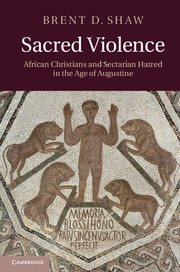Book contents
- Frontmatter
- Contents
- Abbreviations
- Maps
- Acknowledgments
- Introduction
- Chapter 1 This terrible custom
- Chapter 2 Church of the traitors
- Chapter 3 A poisonous brood of vipers
- Chapter 4 Archives of memory
- Chapter 5 The city of denial
- Chapter 6 Ravens feeding on death
- Chapter 7 Little foxes, evil women
- Chapter 8 Guardians of the people
- Chapter 9 In the house of discipline
- Chapter 10 Sing a new song
- Chapter 11 Kings of this world
- Chapter 12 We choose to stand
- Chapter 13 Athletes of death
- Chapter 14 Bad boys
- Chapter 15 Men of blood
- Chapter 16 Divine winds
- Chapter 17 So what?
- Appendix A Bishops and bishoprics in Africa: the numbers
- Appendix B Origins of the division: chronology
- Appendix C The Catholic conference of 348
- Appendix D The Edict of Unity and the Persecution of 347
- Appendix E The mission of Paul and Macarius
- Appendix F Historical fictions: interpreting the circumcellions
- Appendix G The archaeology of suicide
- Appendix H African sermons
- Bibliography
- Index
Appendix F - Historical fictions: interpreting the circumcellions
Published online by Cambridge University Press: 07 September 2011
- Frontmatter
- Contents
- Abbreviations
- Maps
- Acknowledgments
- Introduction
- Chapter 1 This terrible custom
- Chapter 2 Church of the traitors
- Chapter 3 A poisonous brood of vipers
- Chapter 4 Archives of memory
- Chapter 5 The city of denial
- Chapter 6 Ravens feeding on death
- Chapter 7 Little foxes, evil women
- Chapter 8 Guardians of the people
- Chapter 9 In the house of discipline
- Chapter 10 Sing a new song
- Chapter 11 Kings of this world
- Chapter 12 We choose to stand
- Chapter 13 Athletes of death
- Chapter 14 Bad boys
- Chapter 15 Men of blood
- Chapter 16 Divine winds
- Chapter 17 So what?
- Appendix A Bishops and bishoprics in Africa: the numbers
- Appendix B Origins of the division: chronology
- Appendix C The Catholic conference of 348
- Appendix D The Edict of Unity and the Persecution of 347
- Appendix E The mission of Paul and Macarius
- Appendix F Historical fictions: interpreting the circumcellions
- Appendix G The archaeology of suicide
- Appendix H African sermons
- Bibliography
- Index
Summary
Modern historians have placed the men and women known as circumcellions at the heart of a rural rebelliousness – I purposefully use general words – a movement of resistance which, it has been claimed, swept through the African countryside in the fourth and fifth centuries. For centuries by now, beginning before any modern historical interest in them, their violent activities have been catalogued, analyzed, and theorized. Most of the earliest interest in the circumcellions, going back to the sixteenth and seventeenth centuries, was generated by the Protestant Reformation and the interest of its theologians and churchmen in the early history of resistance to the Catholic Church. Works by Friedrich Staphylus, Gustavus Dietz, and others, published in the course of the Lutheran movement in Germany, marked the modern origins of this research. As a result, many details have been assembled and overwrought narratives written about them, but these efforts have not led to much understanding. In a review of the methodological and factual difficulties that bedevil analyses of the circumcellions, Joachim Diesner, an historian of late antiquity who devoted much time and effort to understanding their activities rightly remarked that the circumcellions are “one of those historical phenomena of which we know many things, but about which we really don't know very much.” Because of the peculiar condition of the evidence, this precarious state of affairs remains true. Partly for the same reasons, there have been a number of basic shifts of perspective on the circumcellions, as one dominant historical paradigm has succeeded another in interpreting them, including Marxist approaches that highlighted the “rebels” as prime bearers of the class conflict in late Roman Africa.
If there is any one thing that has fundamentally shifted our understanding of the circumcellions in more recent years, however, it is not any of the new interpretive paradigms about them as such, but rather our profoundly altered knowledge of the general economic circumstances in which their violent actions occurred. Among the continuing verities, there is still no real disagreement with the basic fact that over the long fourth century the Roman empire, especially its western parts, was caught up in a process of military and political disintegration.
- Type
- Chapter
- Information
- Sacred ViolenceAfrican Christians and Sectarian Hatred in the Age of Augustine, pp. 828 - 839Publisher: Cambridge University PressPrint publication year: 2011

